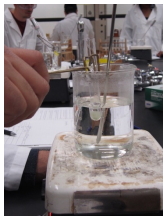1.4H: Water, Sand, and Oil Baths
- Page ID
- 93225
Water, sand, and oil baths are related heat sources as they envelop a flask in a warm material (liquid or sand). A thermometer is often used to monitor the temperature of the bath, and is used to approximate the internal temperature of liquid in a flask (the bath is often slightly hotter than the liquid in the flask).
Water baths, heated on a hotplate, are most commonly used to heat solutions to \(100^\text{o} \text{C}\) (boiling baths, Figures 1.53 + 1.54a). They may also be used to heat to lower temperatures, although it can be difficult to maintain a constant temperature. Water baths can be covered with aluminum foil to prevent excessive evaporation, or to prevent excess moisture from entering open vessels. Cold water baths can also be used to cool apparatuses in a quick manner (Figure 1.54b).

Sand baths, also heated on a hotplate, can be used to heat solutions to a wide variety of temperatures, including very high temperatures (> \(250^\text{o} \text{C}\)). Sand can be placed inside Pyrex crystallizing dishes (as is used with the water bath in Figure 1.54b), although Pyrex may crack if heated at too fast a rate. Sand can also be heated to moderate temperatures inside thin aluminum foil pie dishes, but should not be used at high temperatures as aluminum will then oxidize, causing the thin foil to disintegrate. Thick metal pie tins (Figure 1.54c) are indestructible alternatives when high temperatures are required (but may interfere with the stirring mechanism if used).
A vessel should be buried in a sand bath as much as possible as the surface is often much cooler than the sand below. A scoopula or metal spatula can be used to pile the sand up to at least the height of liquid inside the flask. Sand takes a long time to heat up, and a long time to cool down. To save time, a sand bath may be preheated while an apparatus is assembled as long as it is preheated a distance away from volatile organic liquids.
If the sand overheats and causes a liquid to boil uncontrollably, the flask can be partially lifted out of the sand, or the sand moved with a metal spatula away from contact with the liquid. Sand will remain warm even after turning off the hotplate, and therefore flasks have to be lifted out of the sand bath in order to cool (Figure 1.54d). Hot sand baths can be cooled atop a ceramic tile.
.png?revision=1)
Oil baths are much like water baths, but use silicone or mineral oils in order to enable temperatures hotter than the boiling point of water (> \(100^\text{o} \text{C}\)). Silicone oil baths can be heated to \(250^\text{o} \text{C}\), while mineral oil baths can be heated to \(300^\text{o} \text{C}\).\(^7\) Mineral oil is composed of mixtures of long-chain alkanes, and so is combustible. Direct contact with open flames should therefore be avoided.
Oil baths can be heated in a Pyrex crystallizing dish atop a hotplate. It is also quite common for the oil to be electrically heated, through immersion of a coiled wire connected to a "Variac" (light blue piece of equipment in Figure 1.55a). A Variac connects to the outlet and can deliver variable voltage through the wire. A Variac set to "100" would be equivalent to plugging the system directly into the wall \(\left( 100\% \right)\), while a setting of "50" means the delivered voltage is halved \(\left( 50\% \right)\). By controlling the delivered voltage, Variacs are used to regulate the temperature of the oil. If you have previous experience using a Variac with heating mantles, the settings will not translate to the oil bath as oil bath wires heat more rapidly than a heating mantle's wires. A paper clip can also be used in an oil bath (Figure 1.55c) and stirred with a stirring plate in order to dissipate heat. This allows for the temperature of an oil bath to quickly respond to adjustments up or down.
.png?revision=1)
\(^7\)J. A. Dean, Lange's Handbook of Chemistry, 15\(^\text{th}\) ed., McGraw-Hill, 1999, Sect. 11.3. Additionally, the boiling point of mineral oil is \(310^\text{o} \text{C}\).


